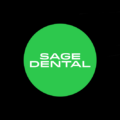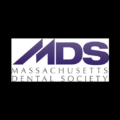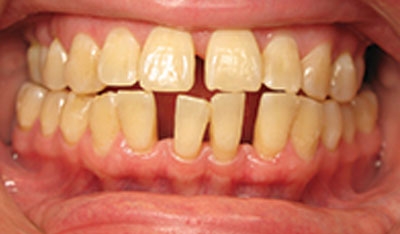
As dentistry evolves, the registered dental hygienist must stay up-to-date with all the latest available treatment modalities. Patients are becoming more involved in their own healthcare decisions, including dental treatment. Although it is not the hygienist who makes an actual dental diagnosis, it is important to be able to discuss, assess, and educate the patient on the current options available.
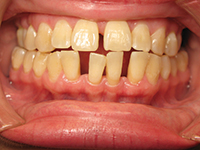 |
| Figure 1. Preoperative photo. (Courtesy of Dr. Percy “Bud” Luecke III, Braceland, San Antonio, Tex.) |
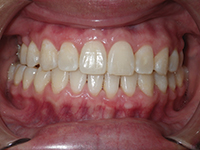 |
| Figure 2. After Invisalign (Align Technology) photo. (Courtesy of Dr. Percy “Bud” Luecke III, Braceland, San Antonio, Tex.) |
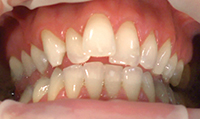 |
| Figure 3. Pre-op of a Six Month Smiles patient. |
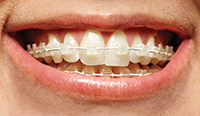 |
| Figure 4. Six Month Smiles orthodontic therapy. |
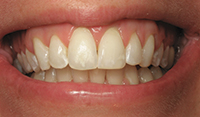 |
| Figure 5. After Six Month Smiles orthodontic treatment. |
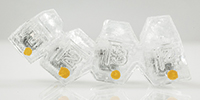 |
| Figure 6. Insignia jig (Ormco) for bracket placement. |
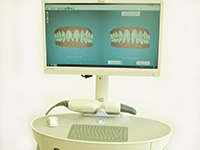 |
| Figure 7. Invisalign Outcome Simulator on the iTero scanner (Align Technology). (Courtesy of Dr. Fernan Rodriguez, Smile Design Orthodontics, Grand Prairie, Tex.) |
Whether it is from advanced dental materials to new periodontal treatment options, the hygienist should be well versed and knowledgeable about current trends and viable treatment modalities. For example, the hygienist should be able to discuss some of the latest options in orthodontics. The hygienist should not be limited to just cleaning around brackets or recording the classification type of occlusion that exists. A hygienist can provide a more comprehensive service to the patient by knowing about and discussing current orthodontic solutions. In addition, if one can assess if the patient’s dental and/or overall systemic health will benefit from orthodontic treatment, a more complete approach to care can be realized. The premise of this article is to provide basic knowledge on orthodontic therapy, and it is not limited to the treatment options mentioned.
Orthodontics
The study of orthodontics is a specialty of dentistry that is concerned with the treatment of malocclusion and/or dentofacial orthopedics, and aimed at modifying the jaw dimensions and relationship of the dentition to the entire facial region. There are varying factors of malocclusion. Slight malocclusion may cause no medical or functional concerns with minimal aesthetic concerns. Severe malocclusion can lead to an array of dental and/or medical issues that can also lead to systemic compromises. Orthodontic treatment is not only for aesthetic reasons, although it may be the primary reason for the patient to seek correction. Malocclusion affects 74% of American adults.1
Orthodontics Versus Periodontal Health
One of the most common reasons to discuss orthodontics with patients is related to their overall periodontal condition. Common sense would indicate that properly aligned teeth should allow for easier and proper patient hygiene; however, studies have been inconsistent with providing conclusive data that can be consistently replicated. Most do not have set criteria and parameters that could be objectively critiqued.2
Crowding can hinder the ability for the patient to properly maintain a healthy oral environment. Plaque and calculus over time can cause periodontal infections such as gingivitis and/or periodontal disease and/or dental decay. If teeth are straightened, the patient can have an increased ability to care for those areas and be able to minimize the bacteria that is the culprit of these issues.
Spacing can also contribute to gingival issues in that the tissues are exposed and do not have the proper protection that normal aligned teeth provide (Figures 1 and 2).3
Systemic Links
In recent years, studies have produced evidence that links periodontal disease to a higher risk of heart disease, diabetes, stroke, and adverse pregnancy concerns, as well as contributing to respiratory issues. This correlation occurs when the bacteria from the oral cavity (infected periodontal pockets) enter the blood stream, affecting a patient’s systemic health. The body responds to the infection with white blood cells to fight off the infection, and the liver produces increased C-reactive protein (CRP) in response to the associated inflammation. The elevation of CRP has been recently linked to heart disease and atherosclerosis. According to the American Heart Association, normal risk ranges from 1.0 to 3.0 mg/L, whereas high risk is > 3.0 mg/L.4,5
Diabetic patients are more likely to develop periodontal disease, which in turn can increase blood sugar and diabetic complications. More than 9% of the adult population has diabetes, and both the incidence and prevalence are increasing every year. According to the American Academy of Periodontology, patients with diabetes are more susceptible to periodontal disease due to the compromised immune system. Malocclusion can contribute to the inability to properly minimize bacteria, and it can add to the complications of the effects of diabetes. Research has shown that those with periodontal issues can exacerbate the inability to maintain stable blood sugar, putting the patient at a greater risk for complications.6,7
Pregnancy and preterm labor have been associated with periodontal disease. An increasing number of studies are confirming this link. Although it is a known fact that alcohol consumption or smoking provide a risk to the patient for pre-term labor/birth, periodontal disease provides the greatest risk of those mentioned. Oral bacteria associated with periodontal disease (such as Bacteroides forsythus, Fusobacterium nucleatum, and Porphyromonas gingivalis) have been associated in preterm birth. If the patient has malocclusion, with less ability to control the bacteria, it contributes to this factor. Theory proposes that periodontal disease accelerates prostaglandin E2 (PGE2) production. In a normal pregnancy, PGE2 production in the amniotic fluid increases gradually throughout the pregnancy. Labor is triggered once the level of PGE2 reaches a certain level.8-11
Current data favors the pathogenesis of oral bacteria in contributing to respiratory issues such pneumonia, acute bronchitis, and chronic obstructive pulmonary disease. One route of entry includes the direct aspiration of bacteria into the lungs. (Pneumonia can occur when bacteria is aspirated into the lung.) In addition, respiratory tract mucosal surfaces can be altered by salivary enzymes associated with periodontal disease. There can also be destruction of salivary films by hydrolytic enzymes that help pathogenic bacteria move into the lungs. Inflammatory molecules and peripheral mononuclear cells present in salvia can also modify the respiratory epithelium and promote infection by respiratory pathogens. For the respiratory compromised patient, it is ideal to minimize such infections by implementing preventive measures to improve or maintain optimal oral health. This may include orthodontic treatment to assist in maintaining a healthy oral environment.12,13
It is advisable to correlate the patient health questionnaire with one’s oral health status, as current health issues may be accelerated by what is occurring in the oral cavity. Maintaining a healthy oral condition can contribute to a better quality of life and longevity for the dental patient.
Effects of Malocclusion
Utilizing orthodontics to align the proper bite can positively impact the health of the teeth, muscles, and joints. Concerns can include crossbites, overbites/deep bites, open bites, and excessive or insufficient overjet.14
When teeth are properly aligned, the chewing cycles are conducive to proper mastication. Crossbites can contribute to digestive concerns, as partially chewed food can be taxing on the digestive system and may even cause nutritional deficiencies. Dysfunctional chewing can lead to occlusal trauma, abnormal wear, and temporomandibular joint issues. Open bites can cause the posterior teeth to perform the duty of the anterior teeth, thus leading to increased wear.
Periodontal issues can be a concern when lower anterior teeth bite into the upper palate when a person has an overbite or deep overbite. It can also lead to abnormal wear on the lower anterior teeth.
Speech impediments can be another issue to consider with malocclusion. Aligned teeth are essential to properly ennunciate words. When maligned teeth are present, it may pose a challenge to properly pronounce sounds like s, r, t, or z where the position of the tongue, in relation to the teeth, is very important.14
Obstructive sleep apnea (OSA) and breathing/snoring issues may sometimes be alleviated with orthodontic treatment. Untreated sleep apnea results in a 20% reduction in life expectancy. There have been a number of OSA treatment protocols developed and prescribed by physicians and dentists for the varying patient diagnoses. One OSA treatment philosophy assesses the patient utilizing Biobloc orthotropic therapy. It involves developing both jaws forward and taking into consideration that the spine forms the rear boundary of the airway. The goal is to correct malocclusions in actively growing children by redirecting maxilla-mandibular growth in a more horizontal direction. This creates a better facial profile and may prevent OSA. Use of appliances using geometric morphometrics improves the oral posture. Thus, appropriate orthodontic movement of the teeth may, in some cases, result in improving a patient’s OSA problem. This technique can also be applied to adults who have issues from previous orthodontic care.15,16
Psychological implications from malocclusion or an asymmetrical smile can impact a patient’s self-confidence and become a driving force to have orthodontic treatment done. Today, there are more viable options for adults who may have originally declined traditional treatment options.17
Conventional bracket and wire consists of placing a metal or ceramic bracket on the tooth using adhesive; and then placing a stainless steel wire, Ni-Ti wire, or ceramic coated Ni-Ti wire that is threaded through the bracket slot and held in place with an elastic ligature. The brackets remain on the teeth until orthodontic treatment is completed, while the wire may be changed frequently for teeth to comply the treatment plan indicated. Movement depends on friction, torque at the wire-bracket interface, type and force of ligation, interbracket distance, salvia, and influence or oral habits. It is important for the patient to have effective home care and to follow directions on foods to avoid, as certain food/candy products may cause bends and/or breaks in the wire and may delay treatment progress.
Self-ligating braces are very similar to the conventional bracket-in-wire braces except that the brackets have an absence of elastic ligature. The braces are typically smaller and more aesthetic since a metal door is required to hold the wires in place. Advantages to this system are reducing the amount of pressure/friction exerted on the teeth because it uses a slide mechanism to hold the archwire. This system usually requires fewer appointments, since elastics do not need to be changed, and it is more comfortable to the patient and easier to keep clean of plaque and food debris. They come with traditional metal, ceramic, or clear brackets that can be categorized as passive or active. Passive brackets use a smaller archwire that creates less friction, allowing teeth to move more freely. Passive brackets are often used at the start of treatment to help get the teeth moving into position. Active brackets use a much thicker archwire, delivering greater pressure to the teeth and more aggressively moving them into position. The active brackets also offer more control for predictable results.18
Other systems of this kind on the market include the Damon System (Clarity SL); Carriere LX (Ortho Organizers); In-Ovation (DENTSPLY GAC), F1000 system (Leone); Empower (American Orthodontics); H4 Self-Ligating System (Ortho Classic), and SPEED System (SPEED System Orthodontics), to name a few.
Short-Term Orthodontic Solutions
Six Month Smiles is an orthodontic system aimed at patients with a high desire for an aesthetic result who do not have issues or functional problems with malocclusion and/or do not want conventional orthodontics. The candidate for this treatment protocol is the patient who wants short-term orthodontic treatment that involves minor changes, focusing on the appearance of visible teeth (Figures 3 to 5).
The Six Month Smiles Patient Tray Kit includes a tray with prepositioned brackets that are ready to be bonded to the teeth. Once clear brackets are secured and bonded, a tooth-colored Ni-Ti wire is attached and changed monthly. Treatment time requires 4 to 9 months, with the average being 6 months. Other fixed braces focus on correcting problems with malocclusion, while the Six Month Smiles system has a cosmetic focus of improving the look of the smile, allowing it to work quicker to achieve the desired results. This is an option for the general dentist who wants to do minor movement of teeth on a patient with an aesthetic outcome as the main desired result. Training for this system includes a 2-day hands-on seminar.19
Customized Systems
The Insignia System (Ormco) is a customized system that allows orthodontists to start treatment with a pre-established result. Using CAD/CAM, the impression is digitized, and a virtual setup is created of the desired outcome in the form of a 3-dimensional (3-D) representation. Brackets are fabricated with customized slots cut into them to allow precision of movement. The brackets are transferred intraorally with an indirect bonding tray composed of jigs to replicate the virtual position of the brackets as seen in the 3-D treatment plan (Figure 6). Treatment continues with custom archwire progression for fast, comfortable, predictable results. With the use of their scanner (Lythos Digital Impression System), a digital impression can be sent direct and incorporated into the process. It can help streamline the digital workflow.20
SureSmile (OraMetrix) uses advanced 3-D imaging with virtual simulations, robotically bending archwires customized to each patient. A convenience factor of SureSmile allows the orthodontist to use his or her preferred bracket system. An initial scan of the patient’s teeth allows for a diagnostic treatment plan to be established. The orthodontist then utilizes conventional bracket placement for the first phase for leveling and aligning. Next, another scan (or cone beam computed tomography image [CBCT]) is completed with the brackets in place for refinement. Then, upon approval of the orthodontist, custom Ni-Ti shape-memory wires are robotically bent to achieve moving teeth to their target position in the most efficient path. This system uses fewer wire changes, due the precision of the customized robots, as compared to bending wires by hand. Another enhancement this system is an upgrade to SureSmile 6.0, which creates a 3-D model from CBCT showing how the treatment will affect root positions in the supporting bone. This allows the orthodontist to use 3 planes of space to simulate an outcome in respect to bone. Interactive data models can assist in collaboration with surgeons and dentists in regards to integration of surgical and restorative planning on more challenging cases.21
Lingual (Hidden) Braces
Incognito (3M ESPE) is a fully customized lingual orthodontic system. Impressions are taken on the patient and a setup is created. Using CAD/CAM technology, the bracket bases, slots, and archwires are individualized to the tooth anatomy and position of the tooth in the dental arch. They are placed on the lingual side of the arch and are also known as “hidden” braces. Brackets are cast in gold for optimal results. These braces are 100% customized to the lingual surfaces of the teeth and highly polished for additional comfort. This system is an option for those patients who have nickel allergies. It is the one system that has 100% compliance and is not visible when the patient smiles.22
(Other lingual systems include SureSmile QT [OraMetrix].)
Removable Options
Invisalign (Align Technology) was introduced in in 1998, after getting FDA approval, as a revolutionary method of orthodontic therapy. The basis of Invisalign is moving teeth without bands, wires, or brackets. This system consists of a series of clear aligners that encompass the teeth 360°. The aligners are custom designed and made for each patient utilizing CAD/CAM technology. The patient is given a series of aligners that are worn for approximately 22 hours per day during a 2-week period. This means the patient will average 300 hours per aligner. (The 2 hours the aligners are not worn allow for eating and oral hygiene care.) Aligners are replaced every other week, with the number of aligners dependent on the extent of the proposed treatment plan. Invisalign has several treatment options available for dentists and orthodontists to choose from Invisalign Assist to Invisalign Full, etc. Aligners are fabricated from a thermoformed medical polycarbonate.
As an option for adults who may want to be more discreet in treating their malocclusion, Invisalign provides a real advantage over traditional bracket and wire orthodontics. It opens up accessibility to a demographic that may not have considered orthodontics as an option. The ability to maintain proper oral hygiene care is also an advantage; the patient can remove the aligner to floss and brush properly, eliminating the decalcification that can be associated with the hygiene challenges found with traditional brackets. Whitening of the teeth can also commence during treatment as the aligner can double as a whitening tray. The comfort factor of the aligner encourages compliance. Since aligners are customized to adapt to the dentogingival junction, there is little-to-no irritation created by brackets, bands, and wires.23 Note clinicians are required to take a one-day course to become a certified Invisalign provider.
Accuracy in the aligner fit is increased with the ability to digitally scan the teeth with the iTero Scanner. The comfort of the scanning process can be another factor to create accessibility for patients who initially decline treatment due to the traditional impression taking process, especially if they have a hypersensitive gag reflex or severe mandibular tori. Scanning a patient’s dentition can create a comfortable patient experience and potentially speed up the process. A chairside application powered by the scanner, called the Invisalign Outcome Simulator, helps patients visualize how their teeth may look after Invisalign treatment (Figure 7).
Other clear aligner systems include Realine (distributed by Henry Schein), the Inman Aligner (Space Maintainers Laboratory [a member of the Appliance Therapy Group]), and Insignia ClearGuide (Ormco), just to name a few.
CLOSING COMMENTS
Before any treatment commences, the orthodontist and/or dentist should have established and recorded the specific characteristics of the malocclusion or dentofacial deformity and the etiology of the issues contributing to the malocclusion. Based on the data collected, the orthodontist/dentist designs a treatment plan based on the patient’s specific needs and desires. The most important part is to present the orthodontic options to the patient so he or she is fully informed regarding the decision at hand. Orthodontic solutions may include fixed and removable treatment therapies, supported by technological advancements, to acquire the desired results and outcome.
It is evident that, for a variety of malocclusion and health concerns, orthodontic therapy should be considered as a part of the overall treatment plan, when indicated. Factors from treating systemic issues to minor tooth movement can be addressed specifically to the patient’s needs and desires. Prescribed orthodontic treatment can be quite sophisticated and technical using up-to-date CAD/CAM and/or cone beam acquisition modalities to obtain a sound end result.
Not only is it important for the registered dental hygienist to be aware that orthodontics can improve one’s quality and longevity of life, but that the knowledge of current orthodontic therapy treatment modalities available will enhance the overall comprehensive care the patient receives. The best part is that the patient ends up with a beautiful and functional smile!
References
- Brunelle JA, Bhat M, Lipton JA, et al. Prevalence and distribution of selected occlusal characteristics in the US population, 1988-1991. J Dent Res. 1996;75:706-713.
- Bollen AM. Effects of malocclusions and orthodontics on periodontal health: evidence from a systematic review. J Dent Educ. 2008;72:912-918.
- Chung CH, Vanarsdall RL, Cavalcanti EA, et al. Comparison of microbial composition in the subgingival plaque of adult crowded versus non-crowded dental regions. Int J Adult Orthodon Orthognath Surg. 2000;15:321-330.
- Nesse W, Dijkstra PU, Abbas F, et al. Increased prevalence of cardiovascular and autoimmune diseases in periodontitis patients: a cross-sectional study. J Periodontol. 2010;81:1622-1628.
- Staufer K, Landmesser H. Effects of crowding in the lower anterior segment—a risk evaluation depending upon the degree of crowding. J Orofac Orthop. 2004;65:13-25.
- Mealey BL. Periodontal disease and diabetes. A two-way street. J Am Dent Assoc. 2006;137(suppl):26S-31S.
- People at “intermediate risk” of heart disease with elevated hsCRP benefit from statin therapy even if cholesterol levels are normal [press release]. Dallas, TX: American Heart Association; August 24, 2010. newsroom.heart.org/news/1098. Accessed September 26, 2013.
- Offenbacher S, Lin D, Strauss R, et al. Effects of periodontal therapy during pregnancy on periodontal status, biologic parameters, and pregnancy outcomes: a pilot study. J Periodontol. 2006;77:2011-2024.
- Jeffcoat MK, Hauth JC, Geurs NC, et al. Periodontal disease and preterm birth: results of a pilot intervention study. J Periodontol. 2003;74:1214-1218.
- Clothier B, Stringer M, Jeffcoat MK. Periodontal disease and pregnancy outcomes: exposure, risk and intervention. Best Pract Res Clin Obstet Gynaecol. 2007;21:451-466.
- Hillier SL, Witkin SS, Krohn MA, et al. The relationship of amniotic fluid cytokines and preterm delivery, amniotic fluid infection, histologic chorioamnionitis, and chorioamnion infection. Obstet Gynecol. 1993;81:941-948.
- Sharma N, Shamsuddin H. Association between respiratory disease in hospitalized patients and periodontal disease: a cross-sectional study. J Periodontol 2011;82:1155-1160.
- Clem DS. The link between periodontal disease and upper respiratory diseases. Inside Dentistry. 2011;7:116.
- Sarver DM, Proffit WR, Ackerman JL. Diagnosis and treatment planning in orthodontics. In: Orthodontics: Current Principles and Techniques. 3rd ed. St. Louis, MO: Mosby; 2000: 146-153, chapter 3.
- Hang H. Obstructive sleep apnea: dentistry’s unique role in longevity enhancement. Journal of the American Orthodontic Society. 2007:7:28-32. orthodontics.com/assets/images/pdfs/aos_journal/JAOSspg07print.pdf. Accessed on October 3, 2013.
- Singh GD, Garcia-Motta AV, Hang WM. Evaluation of the posterior airway space following Biobloc therapy: geometric morphometrics. Cranio. 2007;25:84-89.
- Oland J, Jensen J, Elklit A, et al. Motives for surgical-orthodontic treatment and effect of treatment on psychosocial well-being and satisfaction: a prospective study of 118 patients. J Oral Maxillofac Surg. 2011;69:104-113.
- Cacciafesta V, Sfondrini MF, Ricciardi A, et al. Evaluation of friction of stainless steel and esthetic self-ligating brackets in various bracket-archwire combinations. Am J Orthod Dentofacial Orthop. 2003;124:395-402.
- Swain RB. The Six Month Smiles System: Creating dramatic changes in tooth position and smile symmetry with a novel orthodontic system. Inside Dentistry. 2012;8:1-4.
- Kozlowski JT. A new era in digital orthodontics. Clinical Impressions. 2013;19:4-17.
- Alford TJ, Roberts WE, Hartsfield JK Jr, et al. Clinical outcomes for patients finished with the SureSmile method compared with conventional fixed orthodontic therapy. Angle Orthod. 2011;81:383-388.
- Grauer D, Proffit WR. Accuracy in tooth positioning with a fully customized lingual orthodontic appliance. Am J Orthod Dentofacial Orthop. 2011;140:433-443.
- Kravitz ND, Kusnoto B, BeGole E, et al. How well does Invisalign work? A prospective clinical study evaluating the efficacy of tooth movement with Invisalign. Am J Orthod Dentofacial Orthop. 2009;135:27-35.
Ms. Jones has been passionate about dentistry for more than 20 years. She has a unique background in that she has not only been a registered dental hygienist; she has also worked in a dental laboratory for more than 10 years. She enjoys empowering dental teams to embrace dental technology in the office. With degrees in dental hygiene and a bachelor of science in healthcare management from Southern Illinois University in Carbondale, she believes making technology fun, exciting, and user friendly are the keys to implementing it in the office. She is currently the chair for the American Academy of Cosmetic Dentistry charitable foundation Give Back a Smile, which helps domestic abuse survivors have their smiles restored by volunteer dentists. She is an international speaker and author. She has written articles for Dentistry Today, RDH magazine, Contemporary Product Solutions, and more. She can be reached at jonestec@live.com.
Disclosure: Ms. Jones reports no disclosures.







